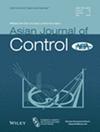Extended state observer‐based trajectory tracking control of a wheeled mobile robot with one unpowered trailer
IF 2.7
4区 计算机科学
Q2 AUTOMATION & CONTROL SYSTEMS
引用次数: 0
Abstract
In this paper, trajectory tracking control is investigated for a wheeled mobile robot with one unpowered trailer using an extended state observer (ESO). The unpowered trailer is added to improve load capacity, which results in a large impact on trajectory tracking as a slow‐varying and large disturbance. A backstepping controller is proposed to generate desired velocities in an outer loop of a double closed‐loop structure. The ESO is employed in an inner loop to estimate the slow‐varying and large disturbance from the unpowered trailer. An integral sliding mode controller is also designed in the inner loop to track the desired velocities from the outer loop. Stability analysis for the ESO, the backstepping controller and the integral sliding mode controller is conducted via Lyapunov methods. Simulation results are provided to show the effectiveness of the trajectory tracking control for a wheeled mobile robot with one unpowered trailer.基于扩展状态观测器的轮式移动机器人轨迹跟踪控制,带一个无动力拖车
本文使用扩展状态观测器(ESO)研究了带一个无动力拖车的轮式移动机器人的轨迹跟踪控制。增加无动力拖车是为了提高负载能力,而无动力拖车作为一个缓慢变化的大扰动会对轨迹跟踪产生很大影响。我们提出了一种反步进控制器,用于在双闭环结构的外环中生成所需的速度。在内环中采用 ESO 来估计来自无动力拖车的慢速变化和大扰动。内环中还设计了一个积分滑动模式控制器,用于跟踪外环中的期望速度。通过 Lyapunov 方法对 ESO、反步控制器和积分滑动模式控制器进行了稳定性分析。仿真结果表明了轨迹跟踪控制对于带一个无动力拖车的轮式移动机器人的有效性。
本文章由计算机程序翻译,如有差异,请以英文原文为准。
求助全文
约1分钟内获得全文
求助全文
来源期刊

Asian Journal of Control
工程技术-自动化与控制系统
CiteScore
4.80
自引率
25.00%
发文量
253
审稿时长
7.2 months
期刊介绍:
The Asian Journal of Control, an Asian Control Association (ACA) and Chinese Automatic Control Society (CACS) affiliated journal, is the first international journal originating from the Asia Pacific region. The Asian Journal of Control publishes papers on original theoretical and practical research and developments in the areas of control, involving all facets of control theory and its application.
Published six times a year, the Journal aims to be a key platform for control communities throughout the world.
The Journal provides a forum where control researchers and practitioners can exchange knowledge and experiences on the latest advances in the control areas, and plays an educational role for students and experienced researchers in other disciplines interested in this continually growing field. The scope of the journal is extensive.
Topics include:
The theory and design of control systems and components, encompassing:
Robust and distributed control using geometric, optimal, stochastic and nonlinear methods
Game theory and state estimation
Adaptive control, including neural networks, learning, parameter estimation
and system fault detection
Artificial intelligence, fuzzy and expert systems
Hierarchical and man-machine systems
All parts of systems engineering which consider the reliability of components and systems
Emerging application areas, such as:
Robotics
Mechatronics
Computers for computer-aided design, manufacturing, and control of
various industrial processes
Space vehicles and aircraft, ships, and traffic
Biomedical systems
National economies
Power systems
Agriculture
Natural resources.
 求助内容:
求助内容: 应助结果提醒方式:
应助结果提醒方式:


